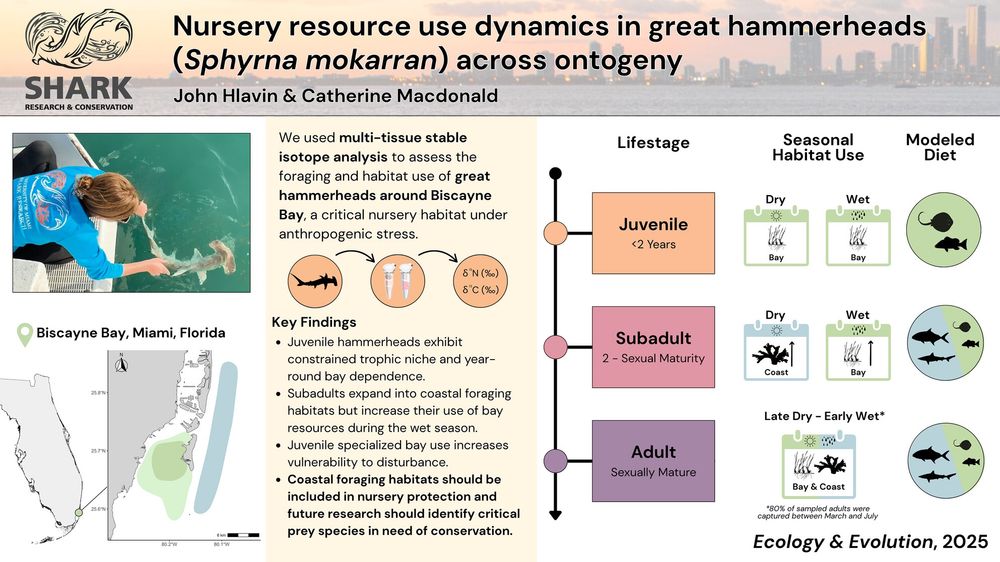
🦈 Marine science communicator
🔗 doi.org/10.1002/ece3.71473

Excited to announce my first publication with @drcatmac.bsky.social on the ontogenetic and seasonal trophic ecology of great hammerheads around the Biscayne Bay nursery! Linked below
onlinelibrary.wiley.com/doi/10.1002/...
Finally, @marinebiojohn.bsky.social John Hlavin, Reconstructing diets of Tiger Sharks in South FL
Finally, @marinebiojohn.bsky.social John Hlavin, Reconstructing diets of Tiger Sharks in South FL
A multi-method approach can help determine the diet of tiger sharks, different methods have pros and cons. Includes data from 67 Tiger sharks- I think I helped get data on 6 of these!

A multi-method approach can help determine the diet of tiger sharks, different methods have pros and cons. Includes data from 67 Tiger sharks- I think I helped get data on 6 of these!
(He thinks they were bait in lobster and crab traps)
(He thinks they were bait in lobster and crab traps)
@dr-yannis.bsky.social 🦑🧪🌊🐟
See the paper: link.springer.com/article/10.1...

@dr-yannis.bsky.social 🦑🧪🌊🐟
See the paper: link.springer.com/article/10.1...
Column quotes @drcatmac.bsky.social
www.forbes.com/sites/meliss...
Column quotes @drcatmac.bsky.social
www.forbes.com/sites/meliss...
www.discoverwildlife.com/animal-facts...

www.discoverwildlife.com/animal-facts...
Recently, I spotted a critically endangered great hammerhead… in the middle of urban Miami. It wasn’t a fluke.
@marinebiojohn.bsky.social & @drcatmac.bsky.social published a study today showing this bay — full of yachts, crab traps, & fishing boats — is a vital nursery habitat. 🌎🦑🧪
Recently, I spotted a critically endangered great hammerhead… in the middle of urban Miami. It wasn’t a fluke.
@marinebiojohn.bsky.social & @drcatmac.bsky.social published a study today showing this bay — full of yachts, crab traps, & fishing boats — is a vital nursery habitat. 🌎🦑🧪
Excited to announce my first publication with @drcatmac.bsky.social on the ontogenetic and seasonal trophic ecology of great hammerheads around the Biscayne Bay nursery! Linked below
onlinelibrary.wiley.com/doi/10.1002/...

Excited to announce my first publication with @drcatmac.bsky.social on the ontogenetic and seasonal trophic ecology of great hammerheads around the Biscayne Bay nursery! Linked below
onlinelibrary.wiley.com/doi/10.1002/...
Congrats to @scrippsocean.bsky.social’s Jack Elstner and team on their new research demonstrating early successes in the application of AI-driven software Ocean Ruler as a citizen science tool for fisheries monitoring!
doi.org/10.1007/s002...

Congrats to @scrippsocean.bsky.social’s Jack Elstner and team on their new research demonstrating early successes in the application of AI-driven software Ocean Ruler as a citizen science tool for fisheries monitoring!
doi.org/10.1007/s002...

Go check it out!
Way to go, Emily!
link.springer.com/article/10.1...

Go check it out!
Way to go, Emily!
Making a starter pack of shark and ray scientists and conservationists.
There are a lot of folks I missed, help me fill this out.
go.bsky.app/Q1x1gJB
🧪🌎🦑🦈🐠
Biscayne Bay is a nursery area for great hammerhead sharks. They start to leave between 140-170 cm in size, expanding their niche without abandoning coastal food sources, varying habitat seasonally.

Biscayne Bay is a nursery area for great hammerhead sharks. They start to leave between 140-170 cm in size, expanding their niche without abandoning coastal food sources, varying habitat seasonally.
I’ve had moderate success as a science communicator on Tiktok, Instagram, Snapchat so this is a new frontier for me. Excited to connect with y’all!
I’ve had moderate success as a science communicator on Tiktok, Instagram, Snapchat so this is a new frontier for me. Excited to connect with y’all!

